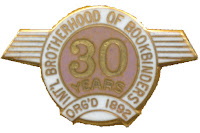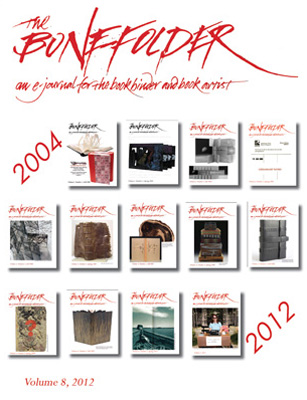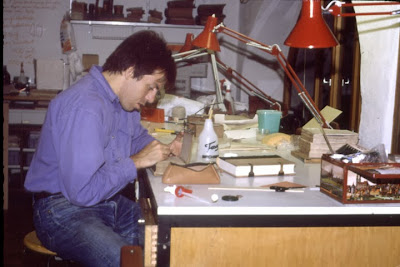Introduction: This series of posts was prompted by questions from Sarah Kim a long-term work-study student of mine at Syracuse University Libraries who is now enrolled in the Bookbinding program of the North Bennet Street School in Boston, fulfilling a dream she’s had for some time. The “interview” is spread out over several posts, so check back regularly… This is Part 4. See here for part 1, part 2, part 3.
Sarah: What do you hope to see from younger people studying books (like students from NBSS, or library science students)?
Good question, and will respond based on my personal experiences and pet peeves from being a listowner, employee, supervisor, mentor, and gadfly/curmudgeon for 30+ years.
I think the most important thing to remember is that no matter what your situation, acknowledge what you don’t know, and that you still have lots of mistakes to make. Keep good notes and keep building your reference and tool collections – you can never have enough, and your heirs (perhaps future mentees?) will thank you. Start a file for any and all clippings, mentions, ... of you and your work, and organize it – useful for when you become famous. Getting covered in the local press (please not as the last bookbinder in the world practicing their lost art under the stairs) is a good start. For your first positions find ones where you will be working under good supervision and hopefully mentorship. Resist hanging out your shingle and going solo right away. Working with/for others allows you to build on what you learned, exposes you to new ways of doing things (even the same things), provides other perspectives, and hopefully a steady stream of work with which you can push yourself and take risks knowing there will be someone to bail you out (or tell you what you could have done to avoid it…). Remember those teachers even when you move on, even if the experience was not your favorite (don’t burn/neglect bridges), and share updates. This doesn’t take much effort long term, and could lead to referrals or even references down the road. If they don’t remember you there won’t be much point in providing anything meaningful.
In terms of goals, especially for the North Bennet Street, Alabama/Iowa type book arts students, aim high, don’t all set out to make journals… Acquire nice fine press, better publishers' textblocks, or ones you can download that can be sewn to bind – these are more interesting than endless blank books. You can often find 1st editions of significant literature for not a lot of $$$ because the bindings are damaged. Textblocks not sewn? Fancy them up like NBSS grad Henry Hebert has done. Liked the term so much I appropriated it. Try to get good edition/production work to develop those chops and muscle memory, something that only repetition can really provide. Find books that interest you (or that you can sell), and create bindings in response to the texts/illustrations. While “self-referential,” books about books can often provide blank canvases on which you can let your creativity be less constrained. Enter exhibitions, set book, themed, or open, non-juried and juried. Local/regional groups are great places to get that first experience, and colleagues will be able to (hopefully positively) critique and provide feedback, something less likely in national shows. Chicago Hand Bookbinders, was a great group in that regard when I first started entering exhibits back in the late 80s. Think about repair and conservation work as well. That's where the jobs are in institutions, and most likely where your bread and butter will come from if on your own. That would include things like Bibles, cookbooks, children's books, ... that often hold deep sentimental value. And in all things, make sure to price your work fairly, including to you.
Ask lots of questions wherever you find your “community,” IRL or online, but think about the question before asking. Is there research you might want to do before asking to help form a better question. Provide all the context you can, provide links to images, ... so that the respondents don’t have to guess or the conversation devolves into an endless cycle of follow-up questions. Don’t assume everything is online and free. The best stuff is in people’s heads, hands, and print. Most of this kind of knowledge cannot be crammed into a tweet, so be prepared to express yourself long-form. Develop good information literacy skills so that you can discern credible sources from the not so credible ones. There is a lot of information that gets passed around that is just bad, or devoid enough of context to be dangerous. Learn to recognize names. Use your real name or that of your business consistently and have a “signature” that provides basic contact/descriptive information. It shows seriousness and gives more credibility. This goes for websites and blogs, too. Provide a bio and contact information. If not your home address, at least what city/state… Websites evolve, so don’t expect them to be perfect the first time around. That said, don’t take them down while you figure out what you want, just tweak, and then release a new look/content when you’re ready. You want to develop your own brand, nurture, and sustain it long term.
I hope to see all of you engaged in the “profession” and become lifelong learners who also contribute actively to the continuation of what we do through their good work, teaching at whatever level, exhibiting, publishing, sharing, … To become mentors like you hopefully had for the next generation. This also carries over to becoming engaged and active in member organizations that contribute to building connections between all of us like the Guild of Book Workers (GBW), the Canadian Bookbinders and Book Artists Group (CBBAG), Designer Bookbinders (DB), Society of Bookbinders (SoB)... Designer Bookbinders have the best journal, so even though UK focused are well worth it. Membership in all more or less the same and a value. All also have regular exhibitions to enter, though most require you to join.
Sarah: I feel like our society today still pressures young people to get a college education. How do you think North Bennet Street School, and other vocational schools, fit into this conversation?
 |
| Int'l Brotherhood of Bookbinders pin. Ca. 1.5 cm wide. |
The trades, including fine crafts, have been marginalized by the idea that everyone has to go to college, including advanced degrees. This has been going on for a long time. Depending on your goals and desired work environment college/advanced degrees may be required, e.g. working as a conservator in a research library/museum environment is one of those situations. Even in private practice, some kinds of grant projects you may find yourself bidding on will have educational/certification requirements.
That said, I wish this country had a well developed system of learning trades, something that would benefit almost all industries and trades. On a national, or even trade-by-trade basis, it would be difficult to build in uniform standards and learning outcomes that are essential for the “degrees” (certificates, certifications, …) to be portable. On a statewide basis that may be possible, especially if coordinated by community colleges and allied programs. There would have to be partnerships with the trades and the business that make it up to ensure that the apprentices/trainees get the practical AND theoretical knowledge in the mechanics of the trade, but also running a business and best practices for that so that they can succeed. They also need and access to networks of peers and mentors. The apprenticeship should have a fixed duration and be paid. After completing their apprenticeships, the newly minted “journeymen” should either be hired by the companies they worked in or be able to find work in others. The former option is common in larger industries - the industry investing in developing its own workforce. It’s a topic I’m glad is seeing more coverage in the mainstream press.
So, this could work for “popular” trades like welding, plumbing, electrical work, construction, … What about fine crafts like bookbinding? Harder because the critical mass of businesses is not there across a broad geographic area and the jobs and work that support them are also not as plentiful as we would like. What core competencies and certification would be broadly agreed upon and available? A North Bennet Street diploma is recognized as are MFA’s but what about for people beyond these, the autodidacts and people in the “fly-over” states. The Guild of Book Workers once thought about certification in some form, but couldn’t agree enough to flesh out the idea. AIC has voted on it at least once and failed, but does have a peer-reviewed Professional Associate and Fellow category. Graduating from a recognized conservation program provides a strong credential, but what about those that entered the field via apprenticeships, also those most likely to work in private practice...
 |
| Int'l Brotherhood of Bookbinders convention ribbon from 1942. |
Then, there is the question of whether people care. After all, we’re not practicing medicine, law, or building airplanes/bridges… This is a question that came up often in AIC discussions, where the hope for certification was a form of regulating the trade and who could practice it akin to the medieval guilds (or modern ones in places like Germany). What would we hope to gain from this certification beyond learning the basic ropes of the trade? Access to group rates for health insurance, accidental death and dismemberment insurance, 401K plans?
I would love to see a flourishing educational and practicing skilled trades and craft “scene,” and feel it could elevate what we do, but only if we (those who practice it) also strongly identify with it and help advertise that greater idea (like displaying diplomas on wall in professional offices). We should also help develop and share educational materials about the trade wherever we appear, kind of like that old ad campaign of looking for the union label.
That brings me back to being professional engaged, and not just looking for the benefits of membership, but “simple” things like actively seeking out PR opportunities and working in the greater field we work in and member organizations in a sustained way. Building those relationships into our individual brands as well so that the general public starts to recognize it… Yes, it’s work, but if a natural extension of what we do becomes second nature.
So, let me flip the question. What do YOU, the reader, student of the craft, budding entrepreneur think? What are you looking for and what are your desired outcomes? Does a structured education/career in the trade matter to you? Are there things you aren’t interested in/willing to do for your career in the trades/crafts? Does any of this matter, and to whom?
Share in the comments below…
 |
| Int'l Brotherhood of Bookbinders stamping die (Backwards, obviously) Ca. 1.5 cm wide. |
































